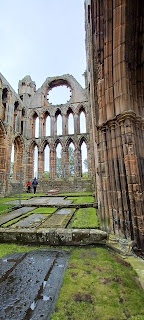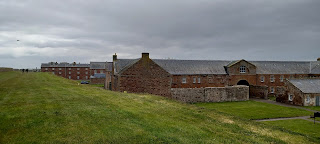In previous posts, we have mentioned Scotland's violent history several times. This post looks at more of that history and some of the places we visited connected with it.
Scotland went through its Protestant Reformation in the 16th century, prior to its union with England in 1707. And unlike England, which switched to Anglicanism by decree of King Henry VIII, the move away from Catholicism in Scotland was more gradual and did not lead to the active destruction of centers of Catholicism. Instead, many Catholic buildings were simply abandoned, and have fallen into ruin with the passage of time. This was the case with Elgin Cathedral.
Elgin Cathedral was started in 1224, and was an extremely important religious center right up until the Scottish Reformation began. It was abandoned, and over 500 years it became a ruin, but with fairly large structures remaining. The photo on the right below is taken from the top of one of the towers in the photo on the left, which can be climbed by tourists willing to navigate several narrow spiraling staircases -- they definitely don't build them like they used to. (Clearly, we were willing and we enjoyed it a lot.)
There were a series of very interesting exhibitions about the architecture and construction of the cathedral on the various levels, making the climb a form of educational exercise. After climbing back down, we walked over to see where the large rose window once resided, along with the intact Chapter House, where the leaders of the cathedral would meet.
Another ruined religious site we visited is Arbroath Abbey, which was founded in 1178 by William the Lion.
The most interesting thing about Arbroath Abbey, however, is not the remaining ruined buildings, but its history. In 1320, after almost 25 years of the Wars of Independence, a group of Scottish barons sent a letter to the Pope asking him to recognize Scotland as a separate country from England, and acknowledge Robert the Bruce as their King. This document, which is believed to have been written by the Abbott of Arbroath is known as the Declaration of Arbroath, and is considered to be the Scottish Declaration of Independence:
As long as a hundred of us remain alive, never will we on any conditions be subjected to the lordship of the English. It is in truth not for glory, nor riches, nor honours that we are fighting, but for freedom alone, which no honest man gives up but with life itself.
This plea to the Pope was successful, and Scotland gained the recognition it sought, but the wars continued until 1346. Less than four centuries later, the 1707 Act of Union formally recombined England and Scotland into a single country. Some historians theorize that the Declaration, and the high number of Scottish immigrants to the US colonies at the time, influenced the U.S. Declaration of Independence.
After 1707, the Jacobites attempted several times to return the Stuart family to the throne of Scotland and England. These attempts were finally put down at the 1746 Battle of Culloden. We visited the battlefield, situated just outside of Inverness, which has an impressive exhibition with a lot of detail about the history leading up to the battle, and took an informative tour where we learned more about the battle and its aftermath. Unfortunately, the weather was terribly cold that day and Culloden is really just a large field, so we don't have any worthy pictures. But we learned how the British Army (the Red Coats, only 30 years before the American Revolution) thoroughly defeated the Jacobites at Culloden and subsequently crushed the clan system and lifestyle among the Scottish Highlanders.
The final stop on this history tour is Fort George (a name that is common in British Colonies, but this is the largest Fort George in the world). (British forts are named after the king who ruled when they were built. We visited Charles Fort and saw James Fort while in Kinsale, Ireland.)
Although history shows that Culloden was the end of Scottish uprisings against England, that was not obvious at the time. So, the English soon began buiding a large fort in the area in order to maintain control. Opened in 1769, Fort George remains a British military outpost to this day.
At the Fort, we visited a museum dedicated to the Scottish Highlander regiments in the British military (one of several in the country). After Culloden, the British made life very difficult for the Scots. As a result, many Highlanders were willing to join the British military to try to improve their lives (in the 18th century, it was literally a way for some of them to eat). And the British were happy to recruit the Scots and place them in harm's way. It turned out, perhaps based on their martial history, that the Highlanders tended to make very good soldiers. Since then, Highlander regiments have fought in every British war, often as part of the vanguard. As a result, they have been killed in far greater numbers than their English counterparts.
Even to this day, there are Scots who seek independence from England, although many of these voices have quieted since the reestablishment of an independent Scottish Parliment in 1999. In 2014, Scotland held a referendum on whether it should be a separate country. Turnout was almost 85%, and the country voted 55-45% to remain part of Great Britian. In other words, the issues in the Declaration of Arbroath have not been resolved almost seven centuries later. Brexit, which was unpopular in Scotland, has many Scots pondering independence again.
More from Scotland soon.






























